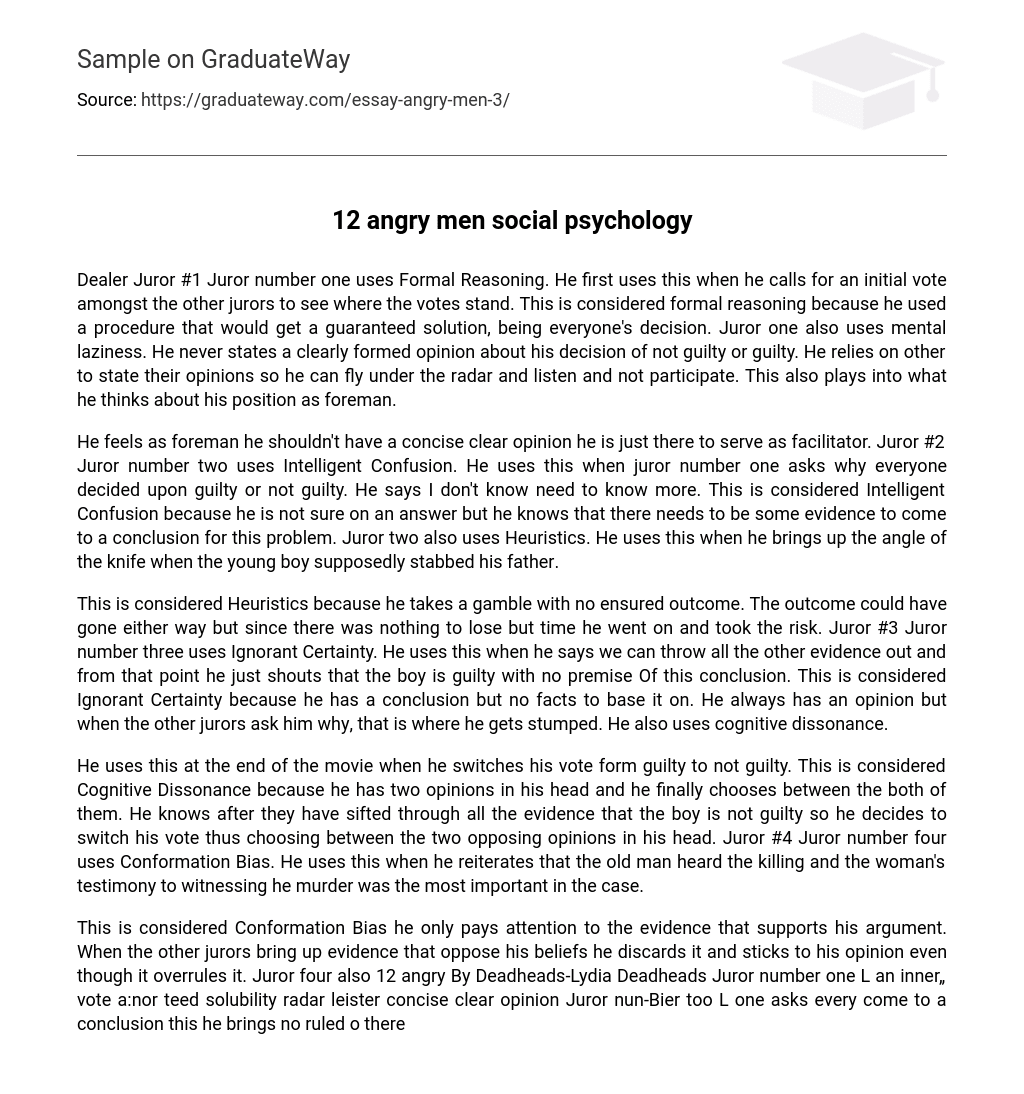Dealer Juror #1 Juror number one uses Formal Reasoning. He first uses this when he calls for an initial vote amongst the other jurors to see where the votes stand. This is considered formal reasoning because he used a procedure that would get a guaranteed solution, being everyone’s decision. Juror one also uses mental laziness. He never states a clearly formed opinion about his decision of not guilty or guilty. He relies on other to state their opinions so he can fly under the radar and listen and not participate. This also plays into what he thinks about his position as foreman.
He feels as foreman he shouldn’t have a concise clear opinion he is just there to serve as facilitator. Juror #2 Juror number two uses Intelligent Confusion. He uses this when juror number one asks why everyone decided upon guilty or not guilty. He says I don’t know need to know more. This is considered Intelligent Confusion because he is not sure on an answer but he knows that there needs to be some evidence to come to a conclusion for this problem. Juror two also uses Heuristics. He uses this when he brings up the angle of the knife when the young boy supposedly stabbed his father.
This is considered Heuristics because he takes a gamble with no ensured outcome. The outcome could have gone either way but since there was nothing to lose but time he went on and took the risk. Juror #3 Juror number three uses Ignorant Certainty. He uses this when he says we can throw all the other evidence out and from that point he just shouts that the boy is guilty with no premise Of this conclusion. This is considered Ignorant Certainty because he has a conclusion but no facts to base it on. He always has an opinion but when the other jurors ask him why, that is where he gets stumped. He also uses cognitive dissonance.
He uses this at the end of the movie when he switches his vote form guilty to not guilty. This is considered Cognitive Dissonance because he has two opinions in his head and he finally chooses between the both of them. He knows after they have sifted through all the evidence that the boy is not guilty so he decides to switch his vote thus choosing between the two opposing opinions in his head. Juror #4 Juror number four uses Conformation Bias. He uses this when he reiterates that the old man heard the killing and the woman’s testimony to witnessing he murder was the most important in the case.
This is considered Conformation Bias he only pays attention to the evidence that supports his argument. When the other jurors bring up evidence that oppose his beliefs he discards it and sticks to his opinion even though it overrules it. Juror four also 12 angry By Deadheads-Lydia Deadheads Juror number one L an inner„ vote a:nor teed solubility radar leister concise clear opinion Juror nun-Bier too L one asks every come to a conclusion this he brings no ruled o there was nothing t Juror nun-Bier three ale. Array: has an opinion of rhea movie noun sifted through all TTL- ,witch his vote theft Juror newer four that the do man HCI Conformation Bias uses Cognitive Dissonance. He uses this when he switch to not guilty. This is considered Cognitive Dissonance be opposing opinions in his head and he finally chooses one the other jurors evidence and he sees how it counts out evidence and switches sides. Juror #5 Juror number five uses a Non-Conscious process. He SSI remembers how someone would use a switchblade.
HTH considered a Non-conscious Process because he came remembered in his conscious thoughts. He suddenly ret someone would only stab underhanded using a switch childhood. He also uses Dialectical reasoning. He uses TTL switchblade to get his point across. This is considered D because he evaluates the evidence and then he relates I says that a switchblade can only be used a certain way, evidence and then used it to support his theory. Juror Juror number six uses Intelligent Confusion. He uses thro before he has a concise decision based on evidence.
HTH Intelligent Confusion because he knows that evidence is with a conclusion so he sits and listens to others. He list opinions and cross references with evidence so that he decision before he comes to one. Juror six also uses cog sees this when he changes his vote from guilty to not gal. Considered cognitive dissonance because he has two pop that contradict one another and chooses one. Once he hi evidence sifted through and debated he is TABLE to choose choices in his head and goes with not guilty.
Juror #7 Juror number seven uses Ignorant Certainty. He uses HTH he has no real evidence to back up his opinion. This is c certainty because he has an opinion but he no evidence guilty in the beginning but doesn’t have evidence when the TABLE and ask for opinions he says he is guilty I just seven also Uses Mental Laziness. He uses this when he c session of not guilty. This is considered Mental Laziness comes to a conclusion without taking the time to make conclusion.
He quickly comes up to the conclusion of no is eleven to one so he can go to his baseball game and the decision of not guilty so that he can go home. Juror I Juror number eight uses a Proposition. He uses this whew opinion of not guilty while everyone else suggests he is everyone state why they think the young boy is guilty. T t Proposition because he is stating an idea or opinion. He boy is not guilty his opinion and he has an idea that eve why they vote opposite. Juror eight also uses heuristics.





